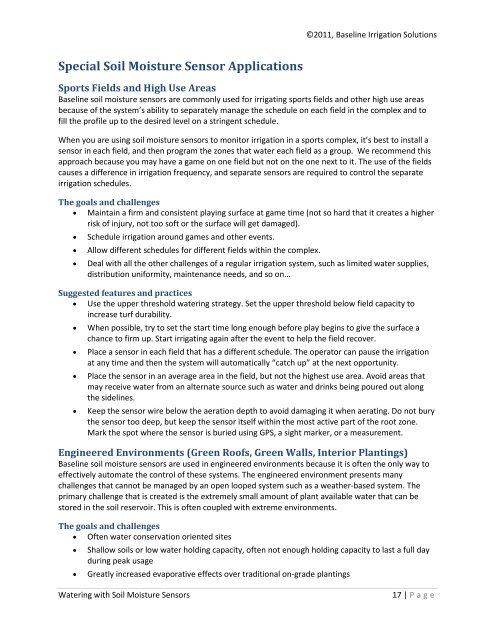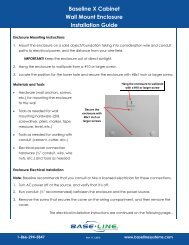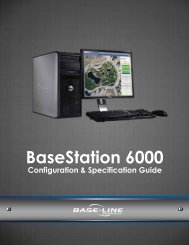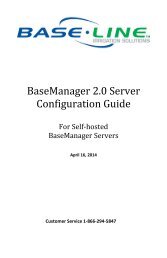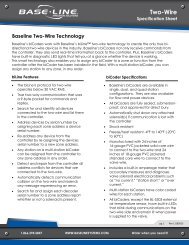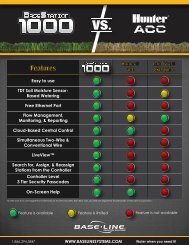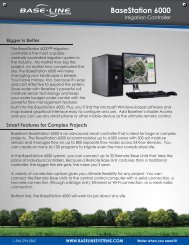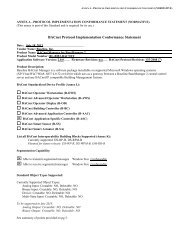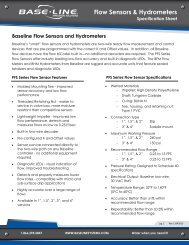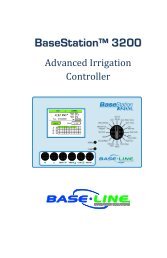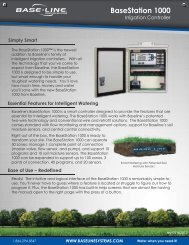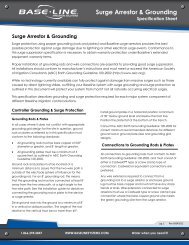Watering with Soil Moisture Sensors - Baseline Systems
Watering with Soil Moisture Sensors - Baseline Systems
Watering with Soil Moisture Sensors - Baseline Systems
You also want an ePaper? Increase the reach of your titles
YUMPU automatically turns print PDFs into web optimized ePapers that Google loves.
©2011, <strong>Baseline</strong> Irrigation SolutionsSpecial <strong>Soil</strong> <strong>Moisture</strong> Sensor ApplicationsSports Fields and High Use Areas<strong>Baseline</strong> soil moisture sensors are commonly used for irrigating sports fields and other high use areasbecause of the system’s ability to separately manage the schedule on each field in the complex and tofill the profile up to the desired level on a stringent schedule.When you are using soil moisture sensors to monitor irrigation in a sports complex, it’s best to install asensor in each field, and then program the zones that water each field as a group. We recommend thisapproach because you may have a game on one field but not on the one next to it. The use of the fieldscauses a difference in irrigation frequency, and separate sensors are required to control the separateirrigation schedules.The goals and challenges• Maintain a firm and consistent playing surface at game time (not so hard that it creates a higherrisk of injury, not too soft or the surface will get damaged).• Schedule irrigation around games and other events.• Allow different schedules for different fields <strong>with</strong>in the complex.• Deal <strong>with</strong> all the other challenges of a regular irrigation system, such as limited water supplies,distribution uniformity, maintenance needs, and so on...Suggested features and practices• Use the upper threshold watering strategy. Set the upper threshold below field capacity toincrease turf durability.• When possible, try to set the start time long enough before play begins to give the surface achance to firm up. Start irrigating again after the event to help the field recover.• Place a sensor in each field that has a different schedule. The operator can pause the irrigationat any time and then the system will automatically “catch up” at the next opportunity.• Place the sensor in an average area in the field, but not the highest use area. Avoid areas thatmay receive water from an alternate source such as water and drinks being poured out alongthe sidelines.• Keep the sensor wire below the aeration depth to avoid damaging it when aerating. Do not burythe sensor too deep, but keep the sensor itself <strong>with</strong>in the most active part of the root zone.Mark the spot where the sensor is buried using GPS, a sight marker, or a measurement.Engineered Environments (Green Roofs, Green Walls, Interior Plantings)<strong>Baseline</strong> soil moisture sensors are used in engineered environments because it is often the only way toeffectively automate the control of these systems. The engineered environment presents manychallenges that cannot be managed by an open looped system such as a weather-based system. Theprimary challenge that is created is the extremely small amount of plant available water that can bestored in the soil reservoir. This is often coupled <strong>with</strong> extreme environments.The goals and challenges• Often water conservation oriented sites• Shallow soils or low water holding capacity, often not enough holding capacity to last a full dayduring peak usage• Greatly increased evaporative effects over traditional on-grade plantings<strong>Watering</strong> <strong>with</strong> <strong>Soil</strong> <strong>Moisture</strong> <strong>Sensors</strong>17 | P age


